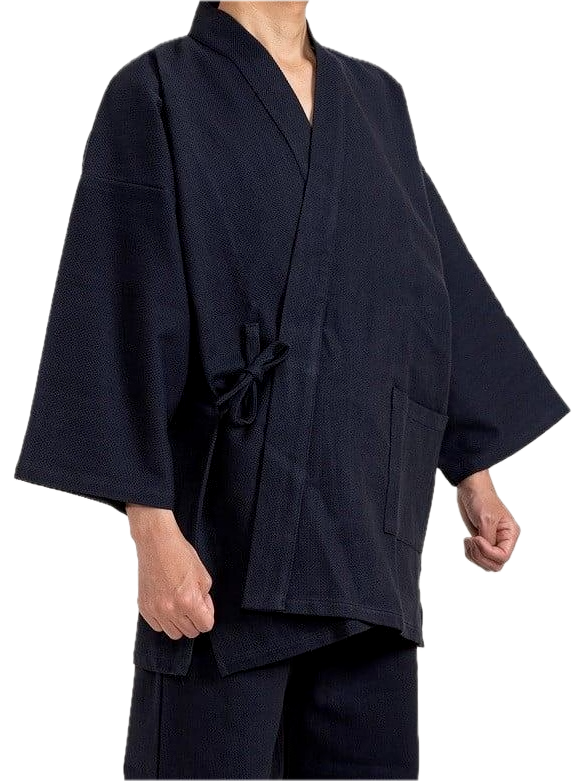How to Care for Your Samue: Washing & Maintenance Tips
How to Care for Your Samue: Washing & Maintenance Tips

Your samue is far more than a piece of clothing—it is a living connection to centuries of Japanese tradition and mindful craftsmanship. Whether you wear it daily for Zen meditation, martial arts training, temple work, creative arts, or as refined leisurewear, the way you care for it determines how beautifully it will serve you over time. Before diving in, explore our complete Samue Collection and discover our customer favorite, the Deluxe Momen Cotton Samue – Made in Japan, celebrated for its premium Kyoto-made fabric and timeless silhouette.
1. Understanding the Samue Heritage
The samue (作務衣) began as workwear for Zen Buddhist monks and temple artisans, a garment designed for quiet tasks such as sweeping courtyards, preparing tea, or tending gardens. Over centuries it evolved into a symbol of relaxed elegance worn by craftspeople, artists, and spiritual practitioners. Today, its appeal spans continents and lifestyles: meditation retreats in Europe, martial arts dojos in the Americas, and stylish lounge wear in modern cities. Respecting this heritage means treating your samue as more than fabric—it is a companion in mindful living.
Each samue reflects a unique combination of fabric and dye. Recognizing these elements is the foundation of proper care:
- Indigo-dyed cotton (aizome): prized for its deep midnight hue and natural antibacterial properties. Indigo is beautiful but tends to bleed during early washes.
- Pure cotton or brushed flannel: warm, breathable, and slightly more absorbent—ideal for cooler climates but prone to shrinkage if overheated.
- Hemp or linen blends: exceptionally light and airy, perfect for humid summers but requiring delicate handling to maintain their crisp texture.
- Poly-cotton or modern blends: wrinkle-resistant, easy to launder, and well-suited for daily wear or travel.
2. Daily Care Between Washes
Preventive care keeps your samue fresh and reduces the frequency of full washes, extending fabric life and saving water.
- Airing after wear: Hang in a shaded, well-ventilated space for at least one hour to release moisture and body heat.
- Spot treatment: Address stains immediately with a damp cloth and pH-neutral soap. Quick attention prevents permanent marks.
- Gentle brushing: Use a soft garment brush to remove surface dust or lint, especially around cuffs and hems.
- Secure cords: Lightly tie inner and outer ties to keep them from tangling or catching on other garments.
Think of these steps as a miniature meditation—each movement a moment of awareness and gratitude.
3. Preparing for Laundry Day
Before washing, inspect seams, cords, and labels. Tighten loose stitches and check dye-fastness by gently dabbing an inconspicuous area with a damp white cloth. If color transfers heavily, plan a separate wash or a first hand-wash cycle.
Mesh laundry bag: A Japanese essential. Place the folded samue inside to minimize abrasion and maintain shape. Detergent choice: Opt for a mild, pH-neutral liquid detergent—avoid bleach, strong alkalis, and optical brighteners, all of which strip natural dyes.
4. Machine Washing the Modern Samue
Many contemporary samue garments are machine-friendly when treated with care:
- Temperature: Cold or lukewarm water (below 40 °C / 104 °F) protects fibers and color.
- Cycle: Select delicate or hand-wash mode with a low spin speed.
- Load size: Wash samue separately or with similarly colored items to avoid friction and color transfer.
- Short spin: Over-spinning weakens threads and sets wrinkles.
- Immediate removal: Take the garment out as soon as the cycle ends to prevent mildew and creases.
5. Hand Washing for Artisan-Dyed Garments
If your samue is hand-dyed—especially with natural indigo or botanical pigments—hand washing remains the gold standard:
- Fill a basin with cool water and add a few drops of mild detergent or indigo-specific soap.
- Gently immerse and press the fabric. Avoid twisting or aggressive scrubbing.
- Rinse two or three times until the water runs clear.
- Press out excess water by rolling the garment in a clean towel—never wring.
This slow, deliberate process honors the artistry of natural dyeing and preserves the subtle depth of color.
6. Drying the Japanese Way
Sunlight is a friend to drying but a foe to colorfastness.
- Shade drying: Hang the samue in a breezy, shaded area to prevent fading.
- Shape while damp: Smooth seams and stretch gently to reduce ironing later.
- Support the shoulders: Use a wide hanger or bamboo pole to maintain structure.
- Avoid tumble dryers: High heat shrinks cotton and weakens hemp fibers.
In humid climates, consider a dehumidifier or fan to speed the process while avoiding direct heat.
7. Ironing & Finishing Touches
- Use a medium-low steam setting.
- Place a thin pressing cloth (ate-nuno) between iron and fabric.
- For textured weaves such as shijira-ori, hover with steam rather than applying pressure.
Many practitioners embrace the natural drape of a samue, seeing each soft crease as a mark of wabi-sabi beauty.
8. Seasonal & Long-Term Storage
Proper storage ensures your garment remains pristine year-round.
- Fold along natural seams to avoid sharp creases.
- Use breathable cotton garment bags; never store in plastic which traps moisture.
- Insert natural repellents such as cedar, camphor, or washi sachets with cloves or lavender.
- Rotate garments during humid summers to prevent mildew.
9. Between-Wash Freshening
- Lightly steam to relax fibers and remove minor odors.
- Hang for 24 hours in an airy space after meditation or light practice.
- Use eco-friendly fabric sprays with essential oils like hinoki or yuzu for a subtle scent of Japan.
10. Repair, Mending & Color Revival
Extending a samue’s life is an act of sustainability and respect.
- Loose seams: Reinforce with simple running stitches.
- Frayed cords: Replace with braided cotton ties or reinforce ends with a small fabric knot.
- Indigo refresh: Professional re-dyeing or home indigo kits can restore depth after years of wear.
11. Eco-Friendly & Mindful Practices
- Wash less often—airing is usually enough after gentle use.
- Choose biodegradable detergents to protect waterways.
- Repurpose worn samue fabric into pouches, meditation cushions, or cleaning cloths.
- Practice mindful folding as a daily meditation, bringing awareness to every motion.
12. Advanced Tips for Enthusiasts
- Water hardness: Soft water keeps indigo vibrant; consider a filter if your supply is hard.
- Travel care: Roll instead of fold and hang immediately upon arrival.
- Climate adaptation: In dry winter air, lightly mist before ironing to prevent static.
- Layering wisdom: In colder months, wear a thin juban (undershirt) to reduce sweat contact and extend wash intervals.
13. Common Mistakes to Avoid
- Using bleach or strong alkalis—these strip natural dyes and weaken fibers.
- Tumble drying or high-spin cycles—cause shrinkage and distortion.
- Leaving damp fabric in the washer—invites mildew and permanent odor.
- Direct high-heat ironing—flattens delicate textures.
- Storing in plastic bags—traps humidity and encourages mold.
FAQ –
How often should I wash my samue?
For meditation or indoor wear, once every three to four uses is sufficient. Airing after each session keeps it fresh.
Can I tumble dry a samue?
No. High heat shrinks cotton and weakens hemp or linen fibers. Always air dry in the shade.
Which detergent is best for indigo?
Use a mild, pH-neutral liquid detergent with no bleach or optical brighteners. Specialty indigo detergents are ideal.
Do I need to iron a samue?
Not necessarily. Many prefer the natural drape, but if you want a crisp look, use a low-steam setting with a pressing cloth.
How can I prevent fading?
Wash in cold water, dry in shade, and store in a cool, dark location with natural insect repellents.
Is hand washing always required?
Not for modern machine-washable samue, but it’s strongly recommended for artisan-dyed or vintage garments.
What’s the best way to store a samue long-term?
Fold along natural seams, place in a breathable cotton bag, and keep in a cool, dry, dark space with cedar or lavender sachets.
Mindful Care as a Spiritual Practice
Caring for a samue is itself a meditation. Each careful fold, each quiet airing, is a reminder of impermanence and respect. When you honor the garment, you honor the artisans who wove it and the Zen lineage that inspired it.
Continue Your Journey:
Explore our full Samue Collection and treat yourself to our top-selling Deluxe Momen Cotton Samue – Made in Japan, crafted in Kyoto for unmatched comfort, elegance, and durability.
















